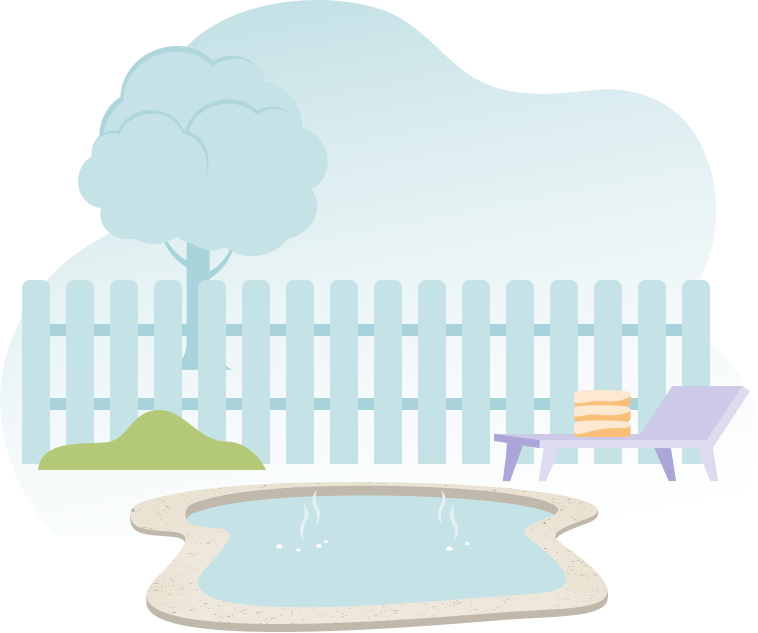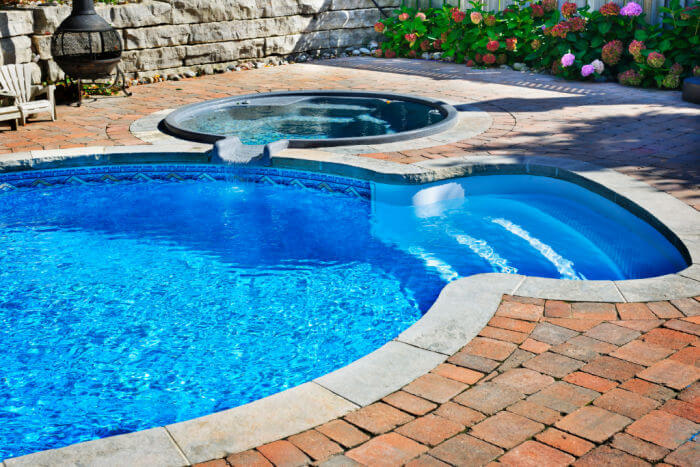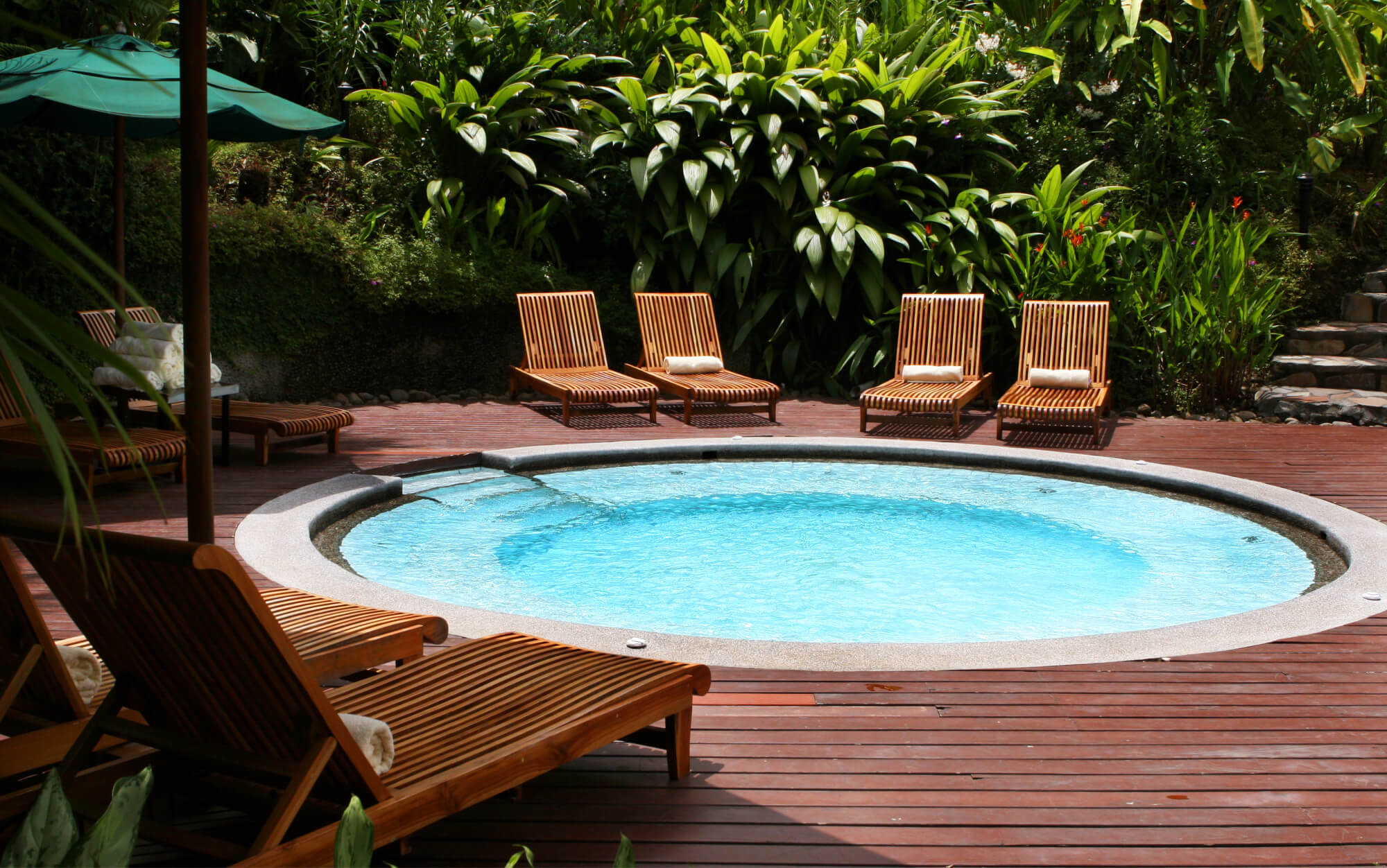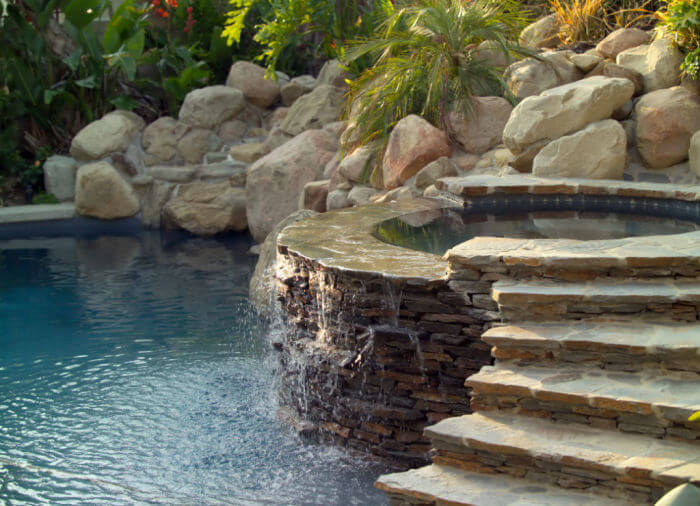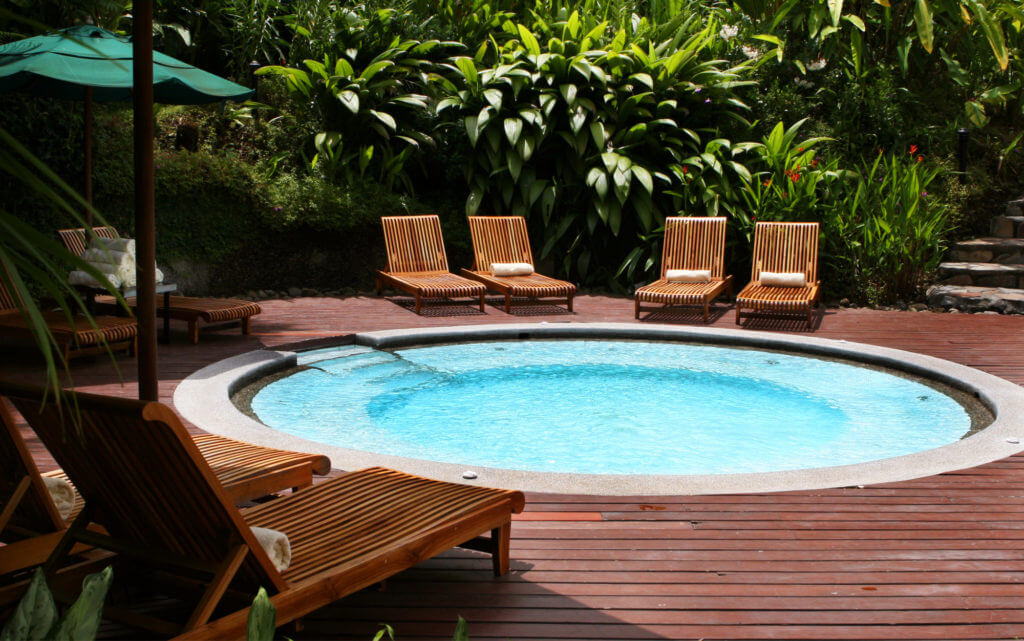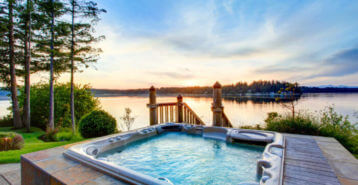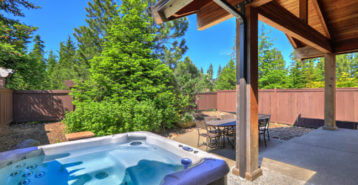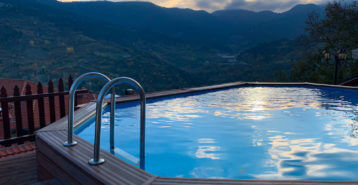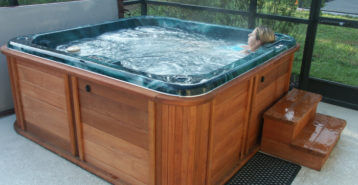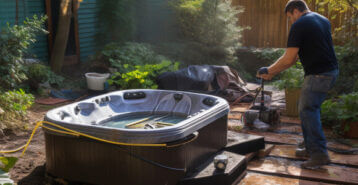Installing a new in-ground hot tub at home can create a relaxing backyard experience while increasing the value of your home. In-ground hot tubs can provide you with a source of stress-relief when enjoying your backyard after a long day, as well as the ultimate way to entertain guests. Whether you are building it adjacent to a pool or looking to elevate your patio area, installing an in-ground hot tub is a great way to improve your home and your life. Modernize can help you explore the details to know ahead of your in-ground hot tub installation, including design elements, cost, sizing, materials to choose from, and more.
Factors to Consider Before Your In-Ground Hot Tub Installation
Installing an in-ground hot tub requires some thoughtful planning and preparation. There are logistical questions to consider when exploring a hot tub installation, as well as brainstorming design ideas. As a homeowner, make sure to consider the following questions before getting in touch with a hot tub professional.
What is your budget?
Determining your budget is the first step to any hot tub installation. Hot tubs come in a variety of sizes and levels of quality. If your budget falls on the lower end, it’s a good idea to find places to cut costs, such as choosing an affordable material. If your budget is on the higher end, you will be able to choose a larger hot tub, add luxury features, and so on.
How much space is available for the hot tub?
Think about the size of your yard and where you want to situate the in-ground hot tub. Do you want the hot tub installed on your patio, or next to your pool? Once you know where the hot tub will be, you can measure the area and decide what size and shape will fit realistically.
Do you already have an in-ground pool?
Homeowners who already have an in-ground pool may want to install their in-ground hot tub adjacent to complete the pool area. Others may decide to install an in-ground pool and hot tub at the same time. If this is the case, your budget will go up significantly, and you’ll want to come up with a holistic design that includes both the pool and hot tub. If you do not intend to build a pool and just want an in-ground hot tub, you can consider stand-alone designs, such as a patio in-ground hot tub.
What materials do you prefer?
There is a variety of options in terms of hot tub materials. You will want to pick out a material for both the interior shell and exterior siding of the hot tub. Consider your landscaping, patio area, and overall backyard design to find a material that works with your current yard. For instance, some homeowners like to use a natural stone or brick shell for their hot tub that matches existing backyard features.
Does your location require permits?
Building codes for different home improvement projects vary by state. While most above-ground hot tubs will not require a building permit to install, most states will require a building permit for an in-ground hot tub installation, especially if you are also building a pool.
How much will the in-ground hot tub cost to operate monthly?
Make sure to not only consider upfront investment costs when calculating your budget, but also monthly operating costs. You will see these operational costs primarily in your energy and utility bills as well as monthly maintenance and servicing fees. Keep in mind that you can cut costs on regular maintenance by doing it yourself.
How Much Does an In-Ground Hot Tub Cost?
As you budget for your in-ground hot tub installation, be sure to consider both upfront and ongoing costs. Of course, installing a new hot tub is an investment for now, but you also need to remember that hot tubs require energy usage that costs you in the form of monthly utility bills. In addition to energy costs, homeowners should also factor in the price of maintenance and cleaning as an ongoing cost.
Upfront Costs
When installing an in-ground hot tub, expect to pay between $8,000 and $25,000 upfront for both the hot tub and installation plus labor. The price range is so wide because the cost largely depends on factors such as size, interior and exterior materials, brand, features, and more.
An entry-level in-ground hot tub with the basic bells and whistles may cost closer to the $8,000 to $10,000 range. A luxury in-ground hot tub can cost $18,000 to $25,000 or even more.
Ongoing Costs
Homeowners will continue to pay to operate their in-ground hot tub on a monthly basis. Plan to pay for maintenance and servicing once per month, as well as energy costs in the form of your utility bill.
|
Energy and utility costs |
Maintenance and servicing |
| $25 – $40 monthly |
$100 – $150 monthly |
You can expect to pay between $25 to $40 in additional monthly utility costs. However, this number largely depends on how often you use your hot tub and the type of heater your hot tub uses.
A 120V heater will use about 1,500 watts (or 3 kilowatt-hours) to run. A 240V heater will use closer to 6,000 watts (or 7.5 kilowatt-hours) when running. Your in-ground hot tub will likely also use small amounts of energy when not in use to maintain its temperature. Before installing, it’s a good idea to ask your hot tub installer about how much energy you can expect your hot tub to use monthly.
In terms of maintenance, homeowners will have to clean, maintain and service their hot tub at least once per month. You can hire a professional to handle this maintenance at an affordable cost, or opt to handle it on your own. Regardless of who handles maintenance, you will need to pay for filtration, water balancing, chemicals, and possibly deep-clean. This should cost around $100 to $150 monthly.
Advantages of In-Ground Hot Tubs
There is so much to love about having an in-ground hot tub at home. Explore some of the top benefits of in-ground hot tubs – compared to portable hot tubs, and otherwise – below.
Disadvantages of In-Ground Hot Tubs
Compared to portable hot tubs (also known as above-ground hot tubs), the following are possible disadvantages of in-ground hot tubs.
Types of In-Ground Hot Tubs
Most homeowners think about types of in-ground hot tubs in terms of shapes and designs, interior and exterior materials, and positioning. Once you determine the shape of the hot tub, aesthetic design, materials, and where you want to locate the hot tub, these factors together will create a custom and unique type of hot tub for your home. Below we cover some common considerations when it comes to designing your in-ground hot tub.
Shapes
To choose a shape and design for your in-ground hot tub, consider the number of seats and the appearance you are going for. Shape also influences how your guests will be seated when in the hot tub. Here are a few common shapes to consider:
- Round. Round hot tubs can be customized in terms of size and seating, and allow for easy conversation. This is why round hot tubs are one of the most common designs.
- Oval. Oval hot tubs function much like round hot tubs in allowing for natural seating and conversation, but also add a bit of unique flair to the appearance.
- Square or rectangular. Square and rectangular hot tubs allow for multiple seats on each of the four ends. These shapes can also be customized and altered, for instance, by rounding the corners or using curved sides.
- Triangular. Triangle shaped hot tubs may not be common, but they can be convenient for smaller spaces while creating a unique design.
- Diamond or hexagon. An even bolder design is the diamond or hexagonal hot tub. These shapes can give your hot tub area a unique look, and can also be customized by adding curved edges or a clover-like design. Hexagonal hot tubs are great for six-seater hot tubs, while diamonds are great for for-seaters.
Positioning and location
- Adjacent to pool. Building a hot tub adjacent to and level with an in-ground pool is a popular design choice. In this instance, the hot tub is nearby, easy to access, and becomes part of the pool area design. With an adjacent hot tub positioning, you can also take advantage of hot tub ideas such as an infinity design or spillover into the pool.
- Stand-alone. Homeowners might choose a stand-alone hot tub design if they do not have an in-ground pool, or want their hot tub to be in a separate area. You might build your stand-alone in-ground hot tub into a patio area, and choose between an elevated design or a design that is level with the patio.
- Elevated or walled. Hot tubs can be elevated from the ground level. Normally, this type of hot tub includes an exterior wall that can be customized to match other outdoor materials, such as natural stone, brick, concrete, or mosaic tile. Elevated hot tubs can either be adjacent to the pool but raised from the ground level, or designed as a stand-alone hot tub.
Materials
Hot tubs can be customized by using different materials for the interior shell and the exterior wall. Homeowners can get creative by choosing specific materials for their hot tub’s wall, especially when going with an elevated design. For instance, you may want to match the wall with your patio flooring material to create a unified look.
In-Ground Hot Tub Sizes
In-ground hot tubs are typically custom-built, so the exact sizing and measurements are left up to the homeowner’s needs. Homeowners usually choose the size of the hot tub based on the number of seats they need, how deep they want the water to be, the shape of the hot tub, and the outdoor space they have available.
However, it may be helpful to get an idea of dimensions so you can better plan for your dream in-ground hot tub. Take a look at the common widths based on the number of seats to get a sense for small, mid-size, and large hot tub sizes.
| Hot tub size | Width |
|---|---|
| Small (2 to 4 seats) | 5’4” to 6’8” |
| Medium (4 to 6 seats) | 6’6” to 7’9” |
| Large (7+ seats) | 7’7” and up |
Sizing will vary depending on the hot tub contractor you are working with. So take these measurements as a basic idea rather than as exact measurements.
In-Ground Hot Tub Features
Many features are considered extra additions to your hot tub installation, and are not required by any means. But including special features in your new in-ground hot tub can create a personalized experience that you will enjoy even more. Ahead of your in-ground hot tub installation, it is worthwhile to consider a few features that might benefit you and your friends and family for years to come.
- Massaging jets. Most hot tub brands will allow you to customize the jets in your in-ground hot tub. Hydrotherapy massaging jets will soothe sore muscles and create a relaxing experience. You can also explore jets that can be rotated and adjusted to focus on certain muscles.
- Spillover waterfall. If you are looking into an in-ground hot tub that is adjacent to your pool, you might add a spillover waterfall from the hot tub to the pool. Not only does this create a unique, tranquil experience, but also acts as a secondary heat source for your pool when the hot tub is in use.
- Bubbling fountain. Add a bubbling fountain to your in-ground hot tub to create a fascinating focal point when in use.
- LED lighting. Custom lighting is not only convenient when you want to enjoy your hot tub at night. It can also create a unique experience with different colors to brighten your hot tub area.
- Built-in steps. Some homeowners choose to build steps for entering elevated hot tubs. Steps can be designed to match your hot tub’s exterior wall or surrounding outdoor area.
- Built-in audio system. Incorporate a sound system to enjoy music when using your hot tub. Many audio systems are Bluetooth controlled or voice controlled, so you can easily control music while using the hot tub.
- Water treatment system. A water treatment system ensures clean water while also saving you time with water filtration maintenance.
- Salt water. While salt water hot tubs are less common than chlorinated hot tubs, there are some benefits of choosing salt water. Salt water is self-sanitizing and provides some hydrotherapy advantages, such as muscle relaxation and easing swelling.
Planning Your Hot Tub Installation
Of course, an in-ground hot tub installation requires the work of a professional. The installation can take as little as 2 to 4 weeks or as long as 10 to 12 weeks, depending on the scope of the project. A professional contractor will also be able to guide you as you customize your hot tub with ideal features, materials, sizing and specs, and help you remain within your budget.
Modernize is here to help you find a reliable and local professional to get the job done. Tell us about the in-ground hot tub you are looking to install. Then, we’ll connect you with our network of professionals so you can find the best contractor for your project needs.
Compare top-rated hot tubs pros in your area.
Read real homeowner reviews, explore qualifications, and view promotions. Modernize makes it easy to browse professionals and find one that will be perfect for your project.
